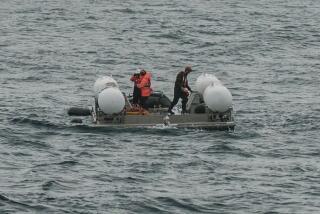Undersea Volcano Studied as Source of Mystery Signals
- Share via
SAN DIEGO — The California scientist who watched an underwater volcano erupt beneath his research ship earlier this month believes he may have discovered the source of certain acoustic signals that have long baffled researchers in the South Pacific.
Harmon Craig, a geochemist at UC San Diego’s Scripps Institution of Oceanography, said Monday that the so-called T-waves observed by seismologists over the last 20 years appear to come from exploding bubbles of gas rising from underwater volcanoes.
Craig said his finding suggests that acoustic equipment could be used to monitor the buildup of similar gas bubbles in volcanic lakes, perhaps making it possible to anticipate the kind of lethal gas emission that killed 1,700 people in Cameroon in 1986.
“I think you could detect that with these T-waves,” said Craig, who intends to recommend that devices called hydrophones be placed in bodies of water like Lake Nios in Cameroon. “It didn’t occur to me before because we didn’t know the origin of these waves.”
Craig was serving as chief scientist on an expedition to study volcanism in the South Pacific and he found himself and the crew of the research vessel Melville directly above the MacDonald Seamount 650 miles southeast of Tahiti as it was erupting on Oct. 11.
In a radio report back to Scripps, Craig described how the ocean at first turned green then chocolate brown, swirling and boiling as gas bubbles rose to the surface, spitting forth “steaming lava balls too hot to hold in bare hands.”
Craig, in his first meeting with reporters since returning to California, said on Monday that T-waves, acoustic waves first discovered traveling through the ocean more than 20 years ago, have never been fully understood.
He said scientists discovered MacDonald Seamount in 1967 after observing T-waves coming from that direction. But they have remained uncertain about the source of the waves, saying only that they appeared to come from the interaction of water and magma from the volcano.
Though the waves are acoustic, they can trigger seismic waves and be recorded by seismic monitoring devices.
More to Read
Sign up for Essential California
The most important California stories and recommendations in your inbox every morning.
You may occasionally receive promotional content from the Los Angeles Times.













